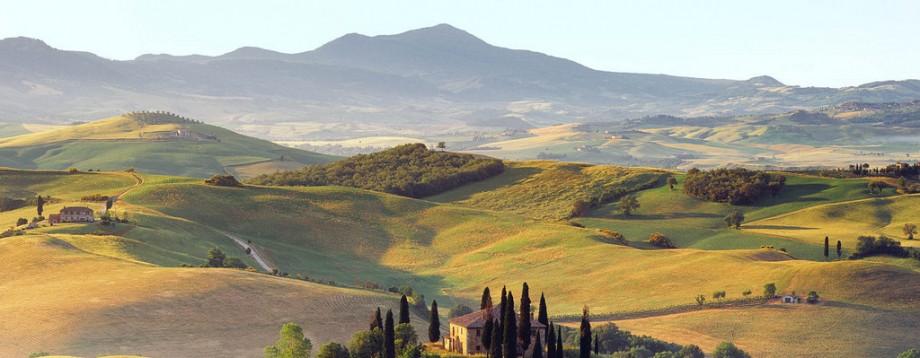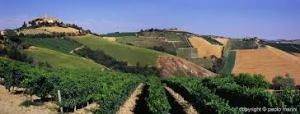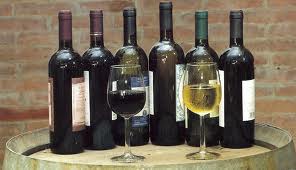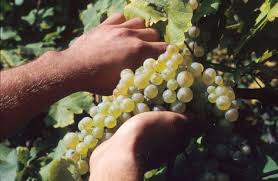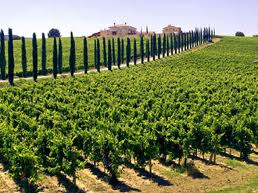Food and Wine of Marche and Wine of Emilia-Romagna
By Sophia Springer
Marche, like most of Italy has wine and food that are special to the region. In the wine area, they are sepcifcally known for their white wines, but they have some good red wines too. Wine in the area was first influenced by the Etruscans, and later the Romans and the Lombards. Within the region, there are many different grape growing conditions which are called terroirs. These different growing conditions consist of different climates, soils, altitude, the position of the vines on slopes, and the presence of water in the area. There are various climates in the region because of the Apennine Mountains, the Adriatic sea and the region’s rivers. These various landscapes make it so that the region has cool and warm zones; so the same grape could be grown in three different places, but taste differently because it has higher altitude or richer soil or more rainfall. About 60,000 acres of Marche are covered by vineyards; these vines produces approximately two million hector liters of wine annually. Most of this wine is sold as Vino di Tavola or under the Indicazione Geografica Tipica title: IGT Marche. The majority of Marche’s DOC wines are both red and white wines.
As stated before, Marche is best known for the whites of the region. The leading white wines of the area are Trebbiano and Verdicchio. These two grades of wine have been produced in Marche for more than six hundred years. Trebbiano, while it is a leading grape in Marche, is also the second most planted grape in the world. It does not have a very distinguished taste, but it can be fresh and fruity while not lasting very long. It is very acidic so it is also important in the making of cognac. Verdicchio derives from the word verde, which means green, and refers to the green color that this wine can have. The DOCGs Verdicchio di Jesi and Verdicchio di Matelica are the best in that range of wines. These two wines are produced in the provinces of Ancona and Macerata. While Verdicchio wine grapes are used to produce still wines, they are also used to make sparkling wine. These types of wines are generally crisp, acidic, and have subtle herbaceous undertones. They are drank primarily with seafood. The white grapes that are widely planted throughout the region are Trebbiano, Verdicchi, Pinot Bianco, Malvasia Toscana, Pecorino, and Bianchello.
While white wine is the region’s main wine focus, Marche does produce many red wines. The better quality reds are generally made from Montepulciano grapes and/or Sangiovese grapes. Sangiovese is the most widely planted red grape variety in Italy. The name derives from sanguis Jovis meaning “the blood of Jove.” It is said that this wine is the product of a crossing between the Ciliegiolo and Calabrese Montenuovo grapes; these two grapes are from Tuscany and southern Italy. Because this grape is grown throughout a large part of Italy it has to be adaptable to different types of soils, although it flourishes in soils with a high concentration of limestone. This grape has a very long growing season because it buds early but is slow to ripen. It also requires a good amount of warm weather to ripen fully but if it is too warm the flavors of the wine can become diluted. Winemakers have found a problem with the Sangiovese grapes though; it often lacks in flavors and color. To fix this problem, winemakers often blend another grape in with the Sangiovese to add body and texture. These wines, while they are able to age, are mainly produced to be consumed fairly early in their lives. The wine naturally has a high acidic component and has a moderate alcohol level. This makes it a very food-friendly wine; it can be paired with pizza, beef, chicken and it generally pairs well with grilled and smoked food. Other red wine grapes from the region are Ciliegiolo, Pino Nero, Lacrima di Morro, and Vernaccia Nera.
While wine is very important to the region, food is also a large part of Marche’s culture. I had stated that Marche has many different climates and graphical variances which affects the wine growing. These graphical variances affect the food too. On the coastal part of the region near the Adriatic Coast, there will be a large supply of seafood. In the more mountainous parts of the region, you can find more local and organic produce. Lamb and suckling pig are common along with local sheep cheeses like casciotta and pecorino. Along with these meats, you often find people accompanying it with lentils which are grown in the Piano Grande which is in the heart of the Apennines. You can also find wild boar and local salami called ciaùscolo. From the Ascoli Piceno area you can find stuffed olives. Found throughout the whole region are truffles. Truffles are fungi and sort of resemble mushrooms. But they are not just any fungi, truffles are quite the delicacy. As I said, they can be found growing throughout the region (mainly in the mountains) and are used in many different dishes.
Emilia-Romagna is also a large wine producing region; more than 136,000 acres of vineyards exist in the region. The wine culture here dates back as fare as the 7th century B.C. and is one of Italy’s older wine regions. As in Marche, vines were introduced by the Etruscans and later adopted by the Romans. About fifteen percent of the wine produced in Emilia-Romagna is considered a DOC wine, and a very small fraction is considered DOCG. Similar to Marche, Emilia-Romagna is very geographically diverse, with rolling hills and the Apennine peaks in the west, low-lying plains east of Parma, Modena and Bologna, and beyond that the coastal plains where most of the land lies below sea level. As in Marche, these geographical differences produce variances within the wine grapes.
Within Emilia-Romagna, wine production is divided evenly between white wines and red wines. The dominant wine grapes used in the area are Malvasia, Lambrusco, Trebbiano, Barbera, Bonarda and Sangiovese. Both Malvasia and Lambrusco vines have various forms that are grown. Many of these grapes are used to produce sparkling wines from the area. Malvasia grapes are used primarily to produce white wines, but there is the occasional red wine produced. They are generally table wines, dessert wines, and fortified wines such as brandy. Lambrusco grapes come in many varieties, the most common six being indigenous to Emilia-Romagna. Most Lambrusco wines are made from one Lambrusco grape variety along with another variety of grape. While the grape is not very sweet, it is often fermented to be a sweet wine; when not fermented it can produce a very nice dry wine with some strawberry undertones.
Food and Wine in the Regions of Umbria and the Food of Emilia Romagna
By Jamie Steele
Umbrian cuisine is something very special and known for its rustic qualities as well as being called “cucina povera”, or peasant cooking. This means that the dishes are built on tradition and created with minimal ingredients and preparation that heavily relies on local products such as grains, vegetables, fresh herbs, and of course olive oil, Umbria’s liquid gold. The traditional dishes of Umbria have been handed down through generations and even today maintain those same principles of simplicity and freshness that originated in Etruscan times.
The Umbrian Region uses seasonal produce in its main dishes such as mushrooms, asparagus, and other fresh produce. The main produce that is Umbria is known for however are their highly prized truffles that are grown throughout the region. Truffles are used in many dishes such as crostini al tartugo, or crostini all norcina. Many of the dishes in Umbria are served with grated black or white truffles. When the truffles are in season there are numerous festivals and markets held to celebrate the regional treat.
Umbrian antipasta is also very typical of the region and can vary from bruschetta topped with olive oil or truffle pastes, the regions own salomi or meat, or even grilled vegetables with local olive oil. A common Umbrian dish in the spring time is made up of fava beans lightly dressed in olive oil and Pecorino cheese, while in the fall the olive oil is harvested and made so it is typical to serve Pinzimonio or Fettunta. Fettunata is grilled bread drizzled with the fresh olive oil and sprinkled with sea salt.
One specific dish that I had the pleasure of trying was strangozzi which was served in a very rich black truffle sauce. My classmates also tried the strangozzi with is spicy tomato sauce and it was a great experience. There are many different pastas that are typical of Umbria that I did not have the pleasure of trying however like umbricelli, and pappardelle alla leper.
Umbria is not specifically known for their soups but they fit all of the guidelines for a traditional Umbrian meal: rustic, fresh local foods and vegetables and always a little bit of olive oil! Because Umbria Is one of the only regions in Italy not located near the sea it is not very well known for its seafood’s. Although it is not located by the sea Umbria is located near Lago di Trasimeno which provides a variety of fish. The main fish dish that Umbria is known for is the Regina in Porchetta which is carp cooked in a wood oven drizzled in olive oil.
Another traditional dish of sorts are Umbrian cured meats. Umbria being a landlocked region is known for its abundance of meats and the way in which they are cooked. I read in an article that “butchers across Italy now use the term norcino to indicate all kinds of meats…” (_) One of the cities that I was fortunate enough to visit, Orvieto, specializes in gallina ubriaca which is basically chicken cooked in local wines! Another town that I was able to visit with my class was the area of Perugia. This part of Umbria specialized in torello alla perugina and roasted lamb head.
Umbrian cheese is traditionally made from cow and sheep milk and can be found in different forms from pecorino which is very typical to the region or ricotta and raviglio. Pecorino cheese can be enjoyed on food or on its own paired with the regions finest Sagrantino wines. Unlike many Italian regions, the wines in Umbria are considered to be a product and not just the only product the area is known for. Instead of finding wineries you’ll find farms with blooming agriculture of grains and meat.
Umbrian bread is a special treat however, the bread varies in different ways but was traditionally salt less when in the 16th century the Pope imposed a salt tax and the people refused. A common favorite of the Umbrian people is a bread called torta al testo which is a flat then bread cooked on a pan that looks very similar to a piadina. It’s usually stuffed with local meats and cheeses or vegetables. A specific dish for Easter time was a cheesy bread made with pecorino cheese and baked into a ring.
Umbrian desserts are almost always traditionally baked in ovens and usually include ingredients such as honey or almonds and local nuts. The desserts of the region are associated with specific religious holidays. Perugia which I had the pleasure to visit is one of the region’s largest cities and also home to delicious pastries and sweets. I was able to taste some of the famous Perugia chocolate fudge with nuts and it was delicious. Other desserts typical of the region are Torciglione which is almond like bread in a serpent shape, Baci di San Franseco or the chocolate fudge that was delicious and also Ciaramicola or sweetheart cake. The Ciaramicola cake is associated with Easter and love and it’s used for young women to give to their suitor.
Now that I’ve covered a wide variety of Umbrian foods I believe it’s time to discuss the wines of the region. Umbrian wine can be traced back to its roots and play into the traditional dishes of the region. One of Umbria’s most famous wines may be its white wine produced from local grechetto grapes found near Orvieto a city I had the pleasure of visiting. Although not as popular as its whites Umbrian red wine is becoming more popular recently especially the Sagrantino di Montefalco which I have a beautiful bottle of from our wine tasting in the region!
Umbria was a pleasure to visit and learn about its culture through food and delicious wine. A blend of good flavors, simple ingredients and fresh food. The quality of Umbrian food is unparalleled and unique to the area as well as traditional. Italian food at its finest!
Now! Let’s take a look into the wonderful history and culture of Emilia Romagna wines. Known for their Sangiovese grapes the wines of Emilia Romagna keep the bold and fruity flavors of the grapes and are cured into great wines. Although Sangiovese grapes are popular to use, there are also Trebbiano and Albana grapes in the region. The Sangiovese grape is known for its fruity flavor and its ability to age with grace. While in the region we had the opportunity to taste wines in a beautiful vineyard and it was an experience like none other. The white wines were delicious and light, while the reds were bold and held even the lightest flavor of a French oak barrel. There are five specific types of wine for the Emilia Romagna region however: first Colli Piacentini, Colli di Parma, Parma Reggio, Colli Bolognesi, and Romagna. These types of wines come from Emilia Romagna’s origins when it was once two spilt regions. “It produces 15% of Italian wine and has seen a steady increase in exports, with the biggest markets represented by Germany, the United States, England, Switzerland, and increasingly Russia, China and Brasil.” (BolognaUncovered). With Emilia Romagna’s history and wine I’m sure that we’ll be seeing more of them all over the world.
Sophia’s Works Cited
In Le Marche. N.p., n.d. Web. 4 May 2014. <http://www.inlemarche.com/cuisine/foodandwine.htm>.
In Le Marche. N.p., n.d. Web. 4 May 2014. <http://www.inlemarche.com/cuisine/foodandwine2.htm>.
Trips 2 Italy. Trips 2 Italy, n.d. Web. 4 May 2014. <http://www.trips2italy.com/marche-food-wine.html>.
Wikipedia contributors. “Lambrusco.” Wikipedia, The Free Encyclopedia. Wikipedia, The Free Encyclopedia, 8 Mar. 2014. Web. 4 May. 2014.
Wikipedia contributors. “Malvasia.” Wikipedia, The Free Encyclopedia. Wikipedia, The Free Encyclopedia, 17 Mar. 2014. Web. 4 May. 2014.
Wikipedia contributors. “Sangiovese.” Wikipedia, The Free Encyclopedia. Wikipedia, The Free Encyclopedia, 25 Apr. 2014. Web. 4 May. 2014.
Wikipedia contributors. “Trebbiano.” Wikipedia, The Free Encyclopedia. Wikipedia, The Free Encyclopedia, 1 Apr. 2014. Web. 4 May. 2014.
Wikipedia contributors. “Verdicchio.” Wikipedia, The Free Encyclopedia. Wikipedia, The Free Encyclopedia, 14 Apr. 2014. Web. 4 May. 2014.
Wine-Searcher. Wine-Searcher, 29 Apr. 2013. Web. 4 May 2014. <http://www.wine-searcher.com/regions-marche>.
Wine-Searcher. Wine-Searcher, 29 Apr. 2013. Web. 4 May 2014. <http://www.wine-searcher.com/regions-marche>.
Jamie’s Works Cited
“DeLallo.com | Emilia-Romagna, Italy.” DeLallo.com. N.p., n.d. Web. 07 May 2014.
“Emilia – Romagna:Between Culture and Agriculture.” WineCountry.it Emilia-Romagna Region Italy. N.p., n.d. Web. 01 May 2014.
Huyghe, Cathy. “Unknown Umbria: A User’s Guide To Food, Wine, And Hospitality.” Forbes. Forbes Magazine, 07 Apr. 2014. Web. 01 May 2014.
Mele, Deborah. “Italian Food Forever » The Foods Of Umbria.” RSS. N.p., 6 Nov. 2011. Web. 01 May 2014.
Schuster, Amanda. “Emilia-romagna Wine.” Snooth. N.p., n.d. Web. 01 May 2014.
Teague, Lettie. “The Heart of Umbria.” Food & Wine. N.p., May 2002. Web. 01 May 2014.
“Umbria Food.” Umbria Wine Umbria Italy Eat. N.p., 25 Dec. 2006. Web. 04 May 2014.
“The Wines of Emilia-Romagna.” Bologna Uncovered. N.p., n.d. Web. 01 May 2014.
